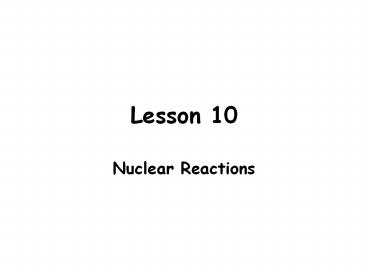Nuclear Reactions - PowerPoint PPT Presentation
1 / 44
Title:
Nuclear Reactions
Description:
... PUBLIC '-//Apple Computer//DTD PLIST 1.0//EN' 'http://www.apple.com/DTDs/PropertyList-1.0.dtd' ... xmlns:xapMM='http://ns.adobe.com/xap/1.0/mm ... – PowerPoint PPT presentation
Number of Views:33
Avg rating:3.0/5.0
Title: Nuclear Reactions
1
Lesson 10
- Nuclear Reactions
2
Nomenclature
- Consider the reaction
- 4He 14N ? 17O 1H
- Can write this as
- Projectile P Target T ?Residual Nucleus R and
Emitted Particle x - Or
- T(P,x)R
- 14N(4He,p)17O
3
Conservation Laws
- Conservation of neutrons, protons and nucleons
- 59Co(p,n)?
- Protons 27 1 0 x
- Neutrons 32 01 y
- Product is 59Ni
4
Conservation Laws (cont.)
- Conservation of energy
- Consider 12C(4He,2H)14N
- Q(masses of reactants)-(masses of products)
- QM(12C)M(4He)-M(2H)-M14N)
- Q exothermic
- Q- endothermic
5
Conservation Laws(cont.)
- Conservation of momentum
- mv(mM)V
- TRTim/(mM)
- Suppose we want to observe a reaction where Q-.
- -QT-TRTM/(Mm)
- T-Q(Mm)/M
6
Center of Mass System
- pipT
- ptot0
- velocity of cm Vcm
- velocity of incident particle v-Vcm
- velocity of target nucleus Vcm
- m(v-Vcm)MV
- m(v-Vcm)-MV0
- Vcmmv/(mM)
- T(1/2)m(v-Vcm)2(1/2)MV2
- TTim/(mM)
7
Center of Mass System
8
Center of Mass System
catkin
9
Kinematics
10
Reaction Types and Mechanisms
11
Reaction Types and Mechanisms
12
Nuclear Reaction Cross Sections
fraction of beam particles that react fraction
of A covered by nuclei a(area covered by
nuclei)n(atoms/cm3)x(cm) (?(effective area of
one nucleus, cm2)) fractiona/Anx? -d??nx? ?tran
s?initiale-nx? ?initial- ?trans
?initial(1-e-nx?)
13
Factoids about ?
- Units of ? are area (cm2).
- Unit of area10-24 cm2 1 barn
- Many reactions may occur, thus we divide ? into
partial cross sections for a given process, with
no implication with respect to area. - Total cross section is sum of partial cross
sections.
14
Differential cross sections
15
Charged Particles vs Neutrons
Iparticles/s
In reactors, particles traveling in all
directions Number of reactions/sNumber of target
atoms x ? x (particles/cm2/s)
16
What if the product is radioactive?
17
(No Transcript)
18
Neutron Cross Sections-General Considerations
19
(No Transcript)
20
Semi-classical?QM
21
The transmission coefficient
- Sharp cutoff model (higher energy neutrons)
- Low energy neutrons
22
1/v
23
Charged Particle Cross Sections-General
Considerations
p(2mT)1/2 (2?)1/2(?-B)1/2 (2??)1/2(1-B/?)1/2
reduced mass ?A1A2/(A1A2)
24
Semi-classical?QM
25
(No Transcript)
26
Barriers for charged particle induced reactions
Vtot(R)VC(R)Vnucl(R)Vcent(R)
27
(No Transcript)
28
Rutherford Scattering
29
Rutherford Scattering
30
(No Transcript)
31
(No Transcript)
32
Consider I0 particles/unit area incident on a
plane normal to the beam. Flux of particles
passing through a ring of width db between b and
bdb is dI (Flux/unit area)(area of ring) dI
I0 (2?b db)
33
(No Transcript)
34
(No Transcript)
35
Elastic (Q0) and inelastic(Qlt0) scattering
- To represent elastic and inelastic scattering,
need to represent the nuclear potential as having
a real part and an imaginary part.
This is called the optical model
36
(No Transcript)
37
(No Transcript)
38
(No Transcript)
39
(No Transcript)
40
(No Transcript)
41
(No Transcript)
42
Direct Reactions
- Direct reactions are reactions in which one of
the participants in the initial two body
interaction leaves the nucleus without
interacting with another particle. - Classes of direct reactions include stripping and
pickup reactions. - Examples include (d,p), (p,d), etc.
43
(d,p) reactions
44
(d,p) reactions































